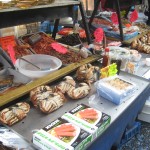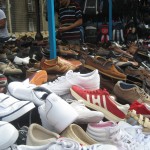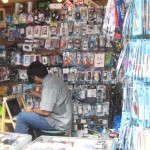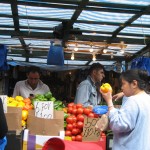Entries from August 2009

As soon as you step off the bus at Brixton, the Caribbean and African influences in the community jump out at you. Signs for jerk chicken, racks of exotic spices, fresh melons and peppers, halal butchers, and the smell of fresh fish overtake your senses. The market extends for about two to three blocks and is full of colorful clothing, food, electronics, and toiletries. It was a bit intense of an experience to see fish so fresh they might still be wriggling, chickens hanging upside down with their heads still in tact, and butchers chopping animals up in the back of a market stand. That being said, many stands boasted products that could be purchased in any local or chain vendor. When asked where the jewelry she was selling was made, a vendor replied, “The factory”. In a similar vein, a different vendor was quite angry when we took a photograph of the DVDs he was selling- proof that they weren’t necessarily the most legal of all goods? Maybe. Still, as you strolled through the market, reggae music that was from other musicians than Bob Marley met your ears to show you that the market was more than just an outdoor equivalent to any old supermarket.



The racial aspect of Brixton was quite striking. The market vendors seemed to hail mostly from Jamaica, Ghana, and Nigeria. People from many different backgrounds crowded both the main street and the market. As soon as you step off the main road, however, you find yourself in a quiet, remote residential community mostly inhabited by white people. So as you journeyed through Brixton, the community seemed quite segregated. The majority of the residential area was white while the majority of those at the market were black. The street that connected these two areas was full of people of all races but the segregation was certainly noticeable. One circumstance made this segregation quite tangible to the three us today. One white man sat in the back of a quite crowded bus next to younger black men. For reasons unbeknownst to us, the black men started yelling and cursing at the white man. When he tried to leave the men, they grabbed his paper and increased the amount of profanity they threw his way. The bus then stopped and the three of us exited quickly to the market. The incident was not violent nor was it necessarily completely race related but it seemed to be if not characteristic than at least not out of place in terms of the tensions in the area.
On the edge of the market, a small plaque sat on the wall of a building. It commemorated those who were killed in a 1999 bombing of Brixton. As we had never before known of Brixton, hearing of a bombing took us by surprise. After researching the occurrence when we got back, we were able to make more sense of it. At the edge of Electric Avenue, a nail bomb was planted by David Copeland, a member of the British neo-Nazi Socialist Movement, in the early evening of April 17th. The group is a far right anti-immigration party. When the bomb exploded, it spit out glass and nails in a 20-foot radius and injured 50 people. He was planning on attacking other cities including Brick Lane and Old Compton Street (other racially and sexually diverse communities). Police accepted his testimony that he worked alone and he was sentenced to six life sentences in prison. This bombing is not an isolated incident in Brixton’s history. It is one example of racial tension that have persisted in the area for years. During the 1980s, the tensions erupted in multiple riots. These riots were usually sparked by the community’s distrust of authority and resulted in increased community damage and heightened tensions between the police and public. This tension continues today as we witnessed in the market. A vendor poked fun at a policeman passing by asking him, “Why aren’t you smiling? You never smile! You smile when you write a ticket though.” While the policeman continued walking by unfazed, the tension between community member and authority was still evident.

As you walk away from the market up a hill, you see a construction site for a proposed community center. Windrush Station will have representations from local community groups including the Black Cultural Archives and the Brixton Society. The name “Windrush Station” comes from the British ship Empire Windrush that brought the first generation of African Caribbean settlers to Britain to Brixton. The community hopes to hold events such as Brixton Splash that celebrate community pride of Brixton. Still, the website that advertises these events has pictures of only young white people who weren’t very prominent at the market that we saw today. So, while the community center promises to increase connectivity and inclusion in Brixton, it is not without the undertones of segregation.
*sidenote* We thought there might be a connection between Eddie Grant\’s \”Electric Avenue\” and Brixton’s Electric Avenue. Comments?
Tags: Audrey · Azul · Brandon · Markets
August 22nd, 2009 · 1 Comment
Recently I travelled with my class to Greenwich to see the Prime Meridian and other famous sites in the town. Instead of taking the tube, we travelled in style, hopping on a boat that took us down the Thames. As we motored down the river, I was beset on all sides with proof that London is truly a town of ever-changing ideas and time periods. Tall and majestic 17th century churches rode right up against uniform concrete estates. In what once was a warehouse district stoop a massive ziggurat-like structure all consisting of flats with views of the Thames. And in walking distance of Greenwich was the monstrously expensive and ugly birthday cake of the Millennium dome. What was once supposed to be a way to promote development in the surrounding area, the Dome stands surrounded by forlorn construction sites.
Once in Greenwich, the scenery took a turn for the better. Beautiful old houses lined the streets and the incredible sites such as the Maritime Museum, the Queen’s House, and the Astronomy Museum were all in shouting distance of each other. After a short hike up a tall hill in the beautiful Greenwich Park, we stopped at the royal observatory and the Prime Meridian. After the obligatory group photo, we were left to our own devices to explore the nearby museums. It was in the Royal Observatory that I learned a bit of the history of the invention of longitude. Perfected by a British clockmaker, longitude allowed mariners to master sea travel and cartography. It should come as no surprise then that the origin point of longitude, the Prime Meridian, should be at any other place than England. Because the English were the first to discover it, England was able to place itself, more specifically its capital, at the origin of everything. It is simply startling to think that things we take to be true without bias, such as the orientation of maps, can be so heavily influenced by nations attempting to gain influence.
Tags: Paul





We arrived at the Camden Town markets around 9:30, after learning that the markets open around 10. In a matter of a half hour, we had found at least 4 different kinds of markets. The first one we explored was the Camden Market, a simple and small market with many snarky T-shirts and punk-rock items. All of us had expected this market to be like the markets you read about in books. Instead of the farmer’s market image with the stands of fresh fruits and vegetables, we were surprised to see many basic retail and punk-rock items. Only a few minutes there were needed. Across the street, was the Inverness Street Market which was smaller and consisted of the produce and tourist stands. However a quick turn put us at the base of the beautiful Camden Lock.
An enchanting bridge provided a pathway into the next part of the Camden market scene. These next three markets: Camden Lock, Interchange and Stable were connected with some indoor, some outdoor, and some both. Camden Lock and Interchange were outdoors and consisted of mostly food stands. Stable, our favorite, was a gigantic, mostly indoor market focusing on vintage clothing and antiques but with different vibes and from different cultures. We were surprised to observe that in the markets there was very little diversity amongst the shoppers. There were mostly white, British, young and middle-age shoppers, hardly any families or other ethnicities. The shops themselves though, were diverse in tastes and products from a Middle Eastern furniture store with beautiful chess sets to Cyberdog, a futuristic-themed clothing and accessory store. At one point there were also 6 restaurants in a row, ranging from Japanese, Indonesian, Mexican, BBQ, Indian, and Italian.
Since the tube stop was packed with people coming off, a quick turn onto a side street revealed a quieter neighborhood with few people about. This could mean that the patrons of these markets are not from Camden town and perhaps that many Londoners are drawn to it as a mecca of the trendy, funky, and diverse.
Having heard so much about Camden Town we were looking forward to spending the day browsing the markets. However, we found that 3 hours was sufficient to get the feel of the area and its visitors.
Tags: Aidan · Alli · Amanda · Markets
We took the Central Line from Goodge Station and switched onto the Waterloo line to Elephant and Castle at Charing Cross. As we moved farther down the line, we noticed that the number of business suits diminished and were replaced by more eccentric garb and hairstyles. After getting off at Elephant and Castle, we started to head in the right direction (towards Walworth Street) only to be re-routed (due to a “fatal accident” involving a bus) down a rather sketchy alleyway, only to make one giant loop and end up where we started. We wandered around, getting even more lost, and after consulting A-Zed, we finally got our bearings and headed down Walworth Street towards the East Street Market. Once there, we were bombarded with a rush of people, wares, sounds and smells. Reggaeton blasted from a CD and cassette tape booth, women in burkas sat under a tent draped with pashmina scarves and the aroma of bangers and burgers hung heavily in the air over the scene. Middle-Eastern and African vendors sold seafood and exotic fruits and vegetables arranged in wooden crates, and women loaded the produce into their bags, bartering with the vendors. There were booths selling watches, clothing (suits, dress shirts, slacks and lingerie), shoes, belts, toys, Christian books and movies, hats, sunglasses, jewelry, bags, scarves, cell phone accessories, linens and toiletry and cleaning products. But more interesting than the wares being sold was observing the interactions between those selling and buying. Vendors, for the most part, kept to themselves and did not call out to passersby. Some left their booths completely vacant and vulnerable to theft. One vendor in particular caught our attention. One of the few white British fruit vendors angrily accosted a potential buyer. As we were passing, we heard the vendor say to the man, “Speaking bloody f***ing English, you f***ing Bangladeshi.” The man walked away from the booth, and responded in very clear English, “English c**t.” We were shocked by witnessing obvious racial tension for the first time. It has become such a common scene in London to see people of all ethnicities sharing common spaces and interacting amicably with one another, and the altercation took us by surprise. Finally, we took the 176 to Tottenham Court Road and headed back home. While tensions do obviously exist in England, places such as East Street Market represent, for the most part, the harmony and co-existence between cultures which necessarily occurs every day in London.
Tags: Andrew F · Andrew R · Anya · Markets

Walthamstow Market
This morning Megan, Mara, and Campbell set off for the Walthamstow Market in the center of Walthamstow Central. Walthamstow Market is the longest consecutive market in the city while by no means the largest. After exiting the train, we were immediately confronted by a large open grass field and a jumbo sized television screen in the center of the square. While this would mostly likely reflect a wealthy upscale neighborhood, the market itself targeted a more middle class to lower class clientele. The majority of people within the market were locals who knew to carry cloth bags or small carts to carry their purchases. This particular market did not cater to tourists, and many of customers were also regulars at produce stalls and small markets. Most items were priced no higher than 8 pounds. The merchants ranged from Cockney to Afro-Caribbean to Middle Eastern. The customers were mainly older women accompanied by young children or older husbands. The market itself is one wide street with stores along both sides and then a center aisle lined with stalls.

Market Stands
The stalls housed “fruit and veg” stands, leather goods, key cutters, clothing, toys, house wares, and fabric. Several of the stalls carried the exact same goods. There was a noticeable difference between the beginning of the street and the end of the market. Towards the front, closest to the bus and train stations, the quality of produce was better and the people running the stalls were mostly white British and then as we walked to the end of the market it became more ethnic. As we progressed, we began to notice the store fronts lining the market were not very well maintained. In the market itself there were a few cafes and food stands, including a rotisserie chicken stand, but the real food was found at the International Food Festival held at the forefront of the market.

Megan rides the kiddie rocket
The food ranged from Asian to German to Latin American, and after sampling goods from several stalls, we found that all the food offered there was exceptional. There were homemade breads and nice cheeses, as well as authentic sausage and even paella. The festival also had several children’s rides, including carousels, rocket ships, and a moon bounce. Megan found the rocket ships to be particularly exciting. The food festival attracted a number of families and couples, and for the first time since arriving in Walthamstow we discovered tourists among the locals.
If you would like to view more photos of the Walthamstow Market or the International Food Festival, please view our slide show: http://s644.photobucket.com/albums/uu163/mliberty2011/Walthamstow%20Market%20Place/?albumview=slideshow
Tags: Campbell · Mara · Markets · Megan
We left the Arran House bright and early at 8am. Together, we boarded the tube and set off for East Aldgate in search of the Whitechapel Market. This proved to be much more of a hassle than we had imagined. As we left the station and entered the streets of Whitechapel, our first perception of the area was the large, pristine East London Mosque, featured below.

From that moment on, we observed many bilingual street signs (in Arabic and English) and small family owned businesses including flower shops, restauraunts, and news agents.

Though there were a plethora of shops, there was a distinct lack of people. We were perplexed by the quiet streets and closed stores and were still unable to locate the elusive Whitechapel Market. Thankfully, a mailman was able to calm our fears…by telling us that it did not exist. He instructed us to walk a few blocks to Commercial Street where we could visit Spitalfields, a predominantly Islamic market. This also proved to be a disaster: it was closed, as we later found out from Professor Qualls, due to the beginning of Ramadan. Below are a few pictures of the deserted market which we imagined, under different circumstances, would otherwise be a vibrant and exciting community.

This is the exterior of the Spitalfield Market!

Here is the interior of the deserted market.
After another panicked call to Professor Qualls, he then directed us to Leadenhall Market which we located on the outskirts of London Proper. Originally a market for fish and cheese mongers, it was established in 1321 as a meeting place for vendors. However in 1666, parts of the original building were destroyed by the Great Fire and then later rebuilt in both 1881 and refurbished in 1990.

This is the entrance into the Leadenhall Markets.
Below is an image that captures the amazing architecture of the market place which is clearly incredibly ornate and a far cry from what we saw in Whitechapel. Not only were there high-end retail stores, but also high-rises and the buildings and streets were noticeably cleaner.
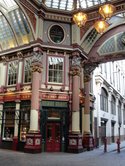
Here is an example of Leadenhall Market's interior!
Despite the fact that the markets were closed, it was still a very enlightening experience, for we saw two different Londons. The first being a predominantly immigrant community that combined the traditional culture of their homelands with the western ideals of Britain. The second was a more commercialized section of the city and felt more like a mainstream city center. It lacked, however, the intimate nature of Whitechapel. All in all, this experience helped us realize the economic and cultural diversity of London!
Tags: Kelley · Kimberly · Maddie · Markets
August 22nd, 2009 · 1 Comment

Outisde the Apple Market
Although it has only been two days, we were beginning to become a little skeptical of A.N. Wilson’s portrayal of a London overrun by American corporations and solely meant for tourism. All of the places that were not already tourist attractions were certainly un-American, and the cuisine was not only worldly but also a surprising amount of fusion food available (Indian/Japanese anyone?). However, after visiting the Covent Garden Market, we caught a glimpse of the England that was made for the tourist. The market is best described as a market for those who want to buy foreign things, but not too foreign. In the Jubilee Market, the shops almost entirely consisted of souvenir and novelty stalls.

A Keychain Shop
People visiting were welcomed to buy everything from London t-shirts, to calendars of David Beckham, and even London-themed condoms (“Want to see Big Ben?”). For those who didn’t have the local currency, there were numerous exchange agents and even stores that accepted American dollars and Euros.
The Apple Market was located in a 12th century abbey where the local monks would grow and sell their vegetables. Keeping in the tradition, there were a variety of chain stores, t-shirt vendors and cafes (The one fruit stand was not even located in the market, but outside one of the entrances).
Of the two markets, Apple seemed to consist more of permanent establishments, however Apple Market’s aim was no different from Jubilee in its desire to attract foreigners, with a welcome sign in several different languages, albeit slightly higher quality.
The surrounding neighborhood also played towards the same theme of tourism, with only the most popular chain retailers lining the streets such as Gap, The Disney Store, Starbucks, H&M, and others. The local theaters were mostly playing shows that had previously or were still on Broadway. Across from the market was the St. Paul’s Church but it was unfortunately closed at the time we were there.

St. Paul's Church
Slightly disillusioned by the cookie-cutter appeal of the Covent Garden area, we decided to walk back to the hotel. It took fifteen minutes of walking until the number of major chain retailers began to decrease and we began to see independent businesses (and pubs!).
The market clearly recognized that this was the type of London that tourists both expected and wanted to see. The shops were easily recognizable, the streets were clean, the vendor made sure that you knew that what you were buying was foreign, and everyone was white.

American Fare
Tags: Markets · Paul · Rebecca · Sarah
Today the Humanities study abroad program ventured out on our first London adventure as a group. The day began with a lovely breakfasts provided by the Arran Hotel. At 8:30 sharp we headed towards Greenwich pier on a boat.
The instant the boat docked and we boarded. I was filled with excitement being that we were within walking distance of what I believed to be the key symbol of London, Big Ben. The boat ride reminded me of the Circle Line Cruise of Manhattan, being that the tour of London was on a boat and went under a numerous amount of bridges. I couldn’t help but feel blessed that I was fortunate to be in London, a place I have only seen in visual media and in my dreams of course. The architecture of each building was unique in its own right, and with modern designed being mixed with the older Georgian monuments only added to the beauty and diversity that is, London.
As we arrived in Greenwich we ventured passed numerous food places, and other historical landmarks. Being separated from the big city, Greenwich proved that its royal history was something to be admired just based off of its architecture. Once we arrived at the Prime Meridian we stopped for a quick photo and proceeded to the two local museums. The first was filled with ancient clock’s and explained the importance of time and how these inventions gave rise to the industrial revolution. We next ventured off into the astronomy museum where we saw an Astronomy show. I was enthusiastic to go into the astronomy show, one because I love stars and the concept of and endless universe, and two because I am in London so I plan to exhaust this experience for all I can get.
The host of the Astronomy show made the entire experience for me, his enthusiasm, vigor, and knowledge in his field made him and excellent pilot for our journey through our solar system and beyond. His humor and tone to his voice kept, and almost complete jetlagged audience, awake and alert. It was a blast.
After the show we headed towards the local pub for food and drinks J. Being that this would be my first legal alcoholic beverage I thought I would go with something very special to me, a Smirnoff ice. After a well put together lunch we proceeded to a nearby flea market and then home on the 188 bus which is one of the few 24hour buses in London. I then purchased a camera for a much needed reason, and then headed out to Camden town, a funky little town just a hop skip and a jump from our hotel. We ate at a local Panini Shop, and then shopped around some rather familiar shops. We then headed back to our hotel, and this American boy, rather pleased with his adventures for the day, headed to be, with the song American Boy played in my ipod as I proceeded to dream and see what tomorrow will have in store. I love London.
Tags: Anthony
Traveling through the Thames River to Greenwich was a magnificent experience which allowed me to view a city that is not always known to visitors or even individuals living in London. Upon walking to the boarding point I realized that Big Ben was visible from where we were standing and has made me realize that I am actually exploring London. Yesterday’s travels were exciting and new; but I was left feeling that I was just in another big city like New York or Los Angeles. Seeing the landmark of London brought upon me this new recognition. The actual boat ride allowed us to view many parts of the city and get me excited for the rest of the trips that we will make throughout London; however, I have also recognized a new interest for architecture. I have noticed the mixture of structures the first day in London when I traveled to Liverpool Street but it seems that such juxtaposition is all throughout the city and while traveling on the water one can distinguish the historical places that were build centuries ago from modern buildings used by corporations and residential buildings which exuded creativity. Walking in Greenwich has allowed me to set my foot back in time. The structures whether it be the Queen’s House or the metal planks left from the industrial period once again shows a diversity that exists in London where the history has integrated with Victorian and Industrial periods.
Upon leaving the Market that was taking place next to the pub, Anthony, Flow and I decided to take the 188 bus through Elephant and Castle and other neighborhoods back home. I was interested in viewing the class and race differences that exist in Gower Street area and those which exist in Elephant and Castle. The difference was definitely present, not only in skin color but also the stores that occupied the streets and the types of housing that we have discussed previously. Upon getting back to Gower Street, we made a visit to a local technology store where an unexpected conversation took place with local salesmen in which the topic of President Obama and how we feel about him rose up as well as our traveling plans and our feelings about London. Overall, I found them friendly and I loved the British humor that they possessed. I am looking forward to interacting more with the British in London and once we get to Norwich. Later that evening, we once again decided to randomly take a bus and head wherever it would take us. We ended up in Camden Town which is probably my favorite part of the city. Filled with rockers of our age and a mix of Columbian music and small boutiques, Camden Town is a place for leisure.
Tags: Jeyla
August 21st, 2009 · 1 Comment
After little sleep, I awoke this morning at 7:30 to begin my journey down the Thames rive; the first event of this trip to really make me feel like I was in London. Coming from New York City, I am used to city life, trains, buses, and lots of people. So exploring the city on our first day and learning the tube was a little less exciting for me. As I walked the streets and rode the train I felt almost like I was still back home, that the plane had circled JFK for 6hrs and 55mins and then just put me back where I started.

Big Ben
But that feeling disappeared as soon as I stepped onto the Ferry boarding dock and spotted Big Ben in the distance. Instantly I realized that there was nothing like this back home. After snapping way too many photos of the distance clock tower, we boarded the Ferry which would take us down the river.
I found the Ferry ride itself to be mostly relaxing, especially considering the low amount of sleep I was running on. We docked near a dirt beach and headed on our long walking tour around Greenwich. Although I found the history and fun facts that we learned along the way interesting, what really got me excited was the details of the architecture. Not only was every single building ornaments with ionic or corinthian columns, but also faces, family crests, and shields. As an art minor, I find the time spent on the monuments and decorative elements of London to be the most beautiful thing about it.

Royal Observatory
For example, when I visited the Royal Observatory today, it was not the clock museum, the view from the telescope tower, or even the amazing planetarium show that I loved most about that part of our day tour, but rather the gorgeous and detailed buildings that housed these things.

"Astronomia" Mermaid Relief
Just as I left the planetarium show (which I encouraged everyone to attend, and turned out to be a huge success!) I spotted a mermaid relief low on the wall across from the exit. On a closer look I found the word “Astronomia” engraved on it. I found that these small details and reliefs awakened my passion for visual arts that the historical facts and information never could.
That is another element of this city that really differs from my home city. Although the architecture of New York will always have a special place in my heart, it lacks the ancient and authentic hand crafted beauty that the old buildings of London have. There is always something very striking to me about the juxtaposition of the modern buildings against the classical structures that founded this city. It is almost like there is a continuing battle between history and modernization. Unfortunately for my passion, it looks like modernization is winning.
If you would like to continue following my adventures, feel free to visit my photo page for a slide show tour of some of the sites I have seen over the past two days: http://s644.photobucket.com/albums/uu163/mliberty2011/London%20the%20first%20two%20days/?albumview=slideshow
After little sleep, I awoke this morning at 7:30 to begin my journey down the Thames rive; the first event of this trip to really make me feel like I was in London. Coming from New York City, I am used to city life, trains, buses, and lots of people. So exploring the city on our first day and learning the tube was a little less exciting for me. As I walked the streets and rode the train I felt almost like I was still back home, that the plane had circled JFK for 6hrs and 55mins and then just put me back where I started.

Big Ben
But that feeling disappeared as soon as I stepped onto the Ferry boarding dock and spotted Big Ben in the distance. Instantly I realized that there was nothing like this back home. After snapping way too many photos of the distance clock tower, we boarded the Ferry which would take us down the river.
I found the Ferry ride itself to be mostly relaxing, especially considering the low amount of sleep I was running on. We docked near a dirt beach and headed on our long walking tour around Greenwich. Although I found the history and fun facts that we learned along the way interesting, what really got me excited was the details of the architecture. Not only was every single building ornaments with ionic or corinthian columns, but also faces, family crests, and shields. As an art minor, I find the time spent on the monuments and decorative elements of London to be the most beautiful thing about it.

Royal Observatory
For example, when I visitied the Royal Observatory today, it was not the clock museum, the view from the telescope tower, or even the amazing planetarium show that I loved most about that part of our day tour, but rather the gorgeous and detailed buildings that housed these things.

“Astronomia” Mermaid Relief
Just as I left the planetarium show (which I encouraged everyone to attend, and turned out to be a huge success!) I spotted a mermaid relief low on the wall across from the exit. On a closer look I found the word “Astronomia” engraved on it. I found that these small details and reliefs awakened my passion for visual arts that the historical facts and information never could.
That is another element of this city that really differs from my home city. Although the architecture of New York will always have a special place in my heart, it lacks the ancient and authentic hand crafted beauty that the old buildings of London have. There is always something very striking to me about the juxtaposition of the modern buildings against the classical structures that founded this city. It is almost like there is a continuing battle between history and modernization. Unfortunately for my passion, it looks like modernization is winning.
If you would like to continue following my adventures, feel free to visit my photo page for a slideshow tour of some of the sites I have seen over the past two days: http://s644.photobucket.com/albums/uu163/mliberty2011/London%20the%20first%20two%20days/?albumview=slideshow
Tags: Megan













